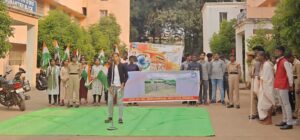Chitalpur is a brilliant example of this Sthambeswari cult where “10 Sthambas” are erected and are still present along with a deity who has been later worshipped as Gramdevati. Author (Sri Amrit Ruturaj)
Chitalpur village in Hindol and the Sthambeswari Cult
Sthambeswari or Khambeswari is a prominent female deity who is generally represented on a pillar of stone. The Cult of Sthambeswari flourished in Western Odisha and in the Ganjam region between the 4th Century to the 12th century C. E. Maharaja Tushtikara, who ruled the present day Kalahandi, Nuapada, Bolangir, Bastar region in the 5th century C. E, has mentioned Goddess Sthambeswari as the presiding deity. Similarly a circular brick temple has been unearthed from Asurgarh in Kalahandi which represents Goddess Sthambeswari. Aska has an old Sthambeswari temple attributed to the kings of Khinjali mandal.
The cult of Sthambeswari peaked its footprints during the Sulki rulers of the Kodalaka Mandala (present day Dhenkanal, Angul) who flourished between the 7th Century C. E to the 10th Century C. E. Initially they were feudatories of the Bhaumakaras but later they probably ruled Kodalaka Mandal independently. Their empire extended up to Sankhajotisha which may be somewhere in Sundargarh near Sankha river.The rulers of this Sulki dynasty named themselves Ranastambha, Kanchanastambha, Jayastambha, Kulasambha etc with their capital at Kualo Village in Parjang block of Dhenkanal. These Sulki rulers considered Goddess Sthambeswari as their presiding deity and used to donate villages to Brahmins as evident from their Hindol, Bhairabgarh, Talcher inscriptions.
Chitalpur is a brilliant example of this Sthambeswari cult where “10 Sthambas” are erected and are still present along with a deity who has been later worshipped as Gramdevati. The deity also stands on a pillar which is the same as the erected pillars outside the temple.
These preserved can be dated to the 8th Century C. E and were probably constructed by Kulastambha as his inscriptions have been found in Hindol. Chitalpur is hardly 20 km from Hindol and is only 4km from the Sukia Bauti temple of Kunua village.
I am hereby attaching photos of the preserved monuments of the Sthambeswari cult from Chitalpur village, Hindol, Dhenkanal – 8th Century C.E.















Post Comment